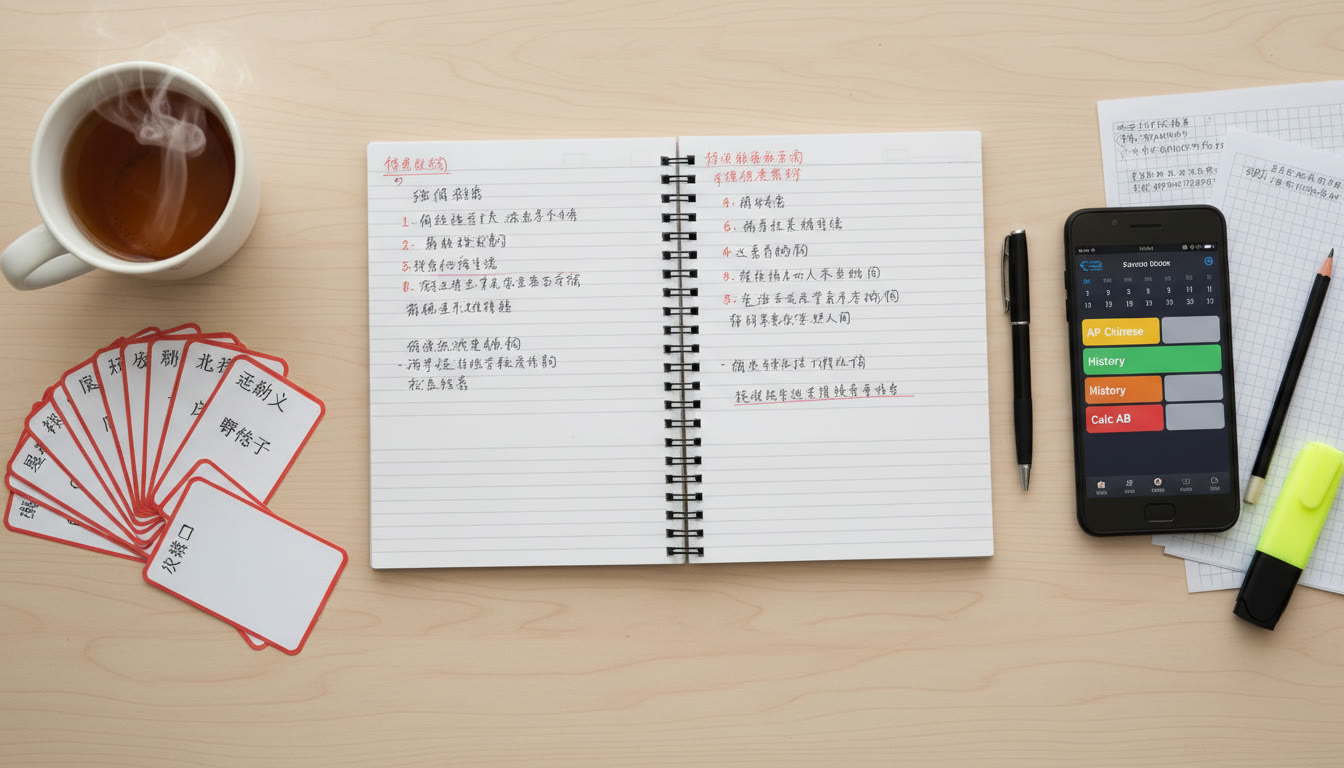Why Stroke Order Matters More Than You Think
When students first meet Chinese characters, the shapes can feel like tiny puzzles—elegant but intimidating. A deceptively simple key to solving those puzzles is stroke order. This isn’t just tradition or aesthetics; stroke order is a practical tool that supports handwriting speed, legibility, character recognition, and most importantly, memory. If you’re preparing for AP Chinese (or just want to write confidently), paying attention to stroke order early saves time, avoids bad habits, and builds deeper, more durable recall.

The cognitive benefits of correct stroke order
There are several cognitive reasons stroke order helps learning:
- Motor memory anchors visual memory: Repeating a consistent motor sequence ties the character to muscle patterns as well as sight.
- Chunking becomes natural: Strokes group into radicals and components—when you learn consistent order, you implicitly learn those chunks.
- Pattern recognition improves: Observing the flow of strokes helps you notice subtle differences between similar characters (e.g., 土 vs. 士).
- Faster proofreading and correction: If you miswrite a stroke, you can mentally replay the order to self-correct before the mistake becomes habitual.
Core Principles of Stroke Order
There are widely taught conventions that make stroke order logical and predictable. Learn these core rules and most characters will start to feel like familiar friends rather than strangers.
Common stroke-order rules (simple and practical)
- Top to bottom: Write strokes that sit above others first (e.g., 二).
- Left to right: When components are side-by-side, start from the left (e.g., 休).
- Horizontal before vertical: For cruciform characters, horizontals usually come first (e.g., 十).
- Outside before inside: Draw the enclosing frame before the inner details (e.g., 同).
- Close frames last: When there is a closing stroke, finish with the closing stroke (e.g., 日—the bottom closes last).
- Center before sides: For symmetrical characters, write the center then the sides (e.g., 小).
How rules apply in real examples
Let’s pick a few characters and imagine the flow:
- 好 (good): Woman (女) on the left: top-to-bottom, left-to-right sequence for its three strokes; Child (子) on the right follows its internal order. Writing left component first follows the left-to-right rule, and writing each radical top-to-bottom keeps things natural.
- 学 (learn): Start with the small roof strokes, then the inner component, then the bottom—outside before inside and top-to-bottom applied together.
- 海 (sea): Water radical 左氵 on the left (three drops top-to-bottom), then the right-hand part—left radical first, matching left-to-right precedence.
Memory Strategies: Beyond Repetition
Repetition matters, but how you repeat makes all the difference. Efficient memory combines spaced practice, meaningful associations, and active retrieval.
1. Spaced repetition with active recall
Space out review sessions over days and weeks rather than cramming. Use a simple schedule: review a new character the same day, one day later, three days later, one week later, then two weeks later. Each review should test active recall (can you write it from memory?) rather than passive recognition.
2. Use radicals as memory anchors
Radicals are the building blocks. When you know that the ‘氵’ hints at water-related meaning or that ‘讠’ signals speech-related characters, you get semantic hooks that reduce the burden on rote memorization. Group characters by radical and practice clusters of 5–10 that share the same component.
3. Create tiny stories and visual mnemonics
Turn confusing characters into mini-scenes. For example, for 往 (to go toward), imagine someone walking forward (彳) with a direction—this playful narrative makes the character stick. Keep the stories short and vivid; the goal is association, not a bedtime novel.
4. Write for meaning, not just form
Practice characters in short, meaningful sentences rather than isolated lists. Context strengthens retrieval: when you recall the sentence, the character comes along for the ride.
Practical Daily Routine: 6-Week Plan for AP Chinese Students
Below is a practical routine structured around six weeks. It balances new learning, reinforcement, writing practice, and interpretation—useful for AP preparation or general fluency.
| Week | Focus | Daily Time | Key Activities |
|---|---|---|---|
| 1 | Foundations | 30–45 min | Learn 30 common radicals, stroke order drills, copy 15 characters, flashcard setup. |
| 2 | Core Characters | 45–60 min | Learn 50 high-frequency characters, write each 5 times with stroke order, start spaced review. |
| 3 | Contextual Use | 45–60 min | Practice characters in sentences, 10-minute timed handwriting, begin short translations. |
| 4 | Speed and Accuracy | 60 min | Timed writing sets, error analysis, group characters by similar strokes, targeted drills. |
| 5 | Active Retrieval | 45–60 min | Blind writing from English prompts, dictation practice, simulated AP writing tasks. |
| 6 | Refinement & Test Readiness | 60–90 min | Full practice sessions, common mistake review, finalize personal revision list. |
How to structure each study day
- Warm-up (5–10 min): Stroke drills—repeat simple radicals to get the motor flow.
- New learning (15–25 min): Introduce 5–10 new characters with stroke-order demonstration, verbalize each stroke as you write it.
- Context practice (10–20 min): Use the new characters in sentences or mini-translations.
- Review (5–15 min): Flashcards, active recall, or a quick dictation.
Tools and Techniques Students Love
You don’t need fancy apps to improve, but the right tools make practice efficient and focused.
Low-tech essentials
- Grid paper (squared or Tian Zi 格子 paper) to keep proportions consistent.
- Quality pen or brush pen for tactile feedback—thicker tips can highlight stroke order movements.
- Physical flashcards for tactile review—write the character on one side and pinyin/meaning on the other.
High-tech helpers
Digital tools that track spaced repetition and let you practice stroke order can be great supplements. Use them for quick reviews when you’re on-the-go but keep handwriting practice in your routine to reinforce motor memory.
Common Pitfalls and How to Fix Them
Even motivated students fall into traps. Here are frequent problems and concrete fixes.
Pitfall: Writing too fast, ignoring stroke order
Fix: Slow down deliberately. Use a five-second-per-character rule for new characters—write slowly enough to feel the order. Speed can come later.
Pitfall: Learning characters in isolation
Fix: Group by meaning, radical, or usage. Practice characters inside phrases or sentences so retrieval becomes context-rich.
Pitfall: Skipping review until it’s urgent
Fix: Build short, daily review windows—10 minutes every evening beats one two-hour cram session.
Assessing Progress: Simple Metrics That Work
Quantify improvement with straightforward metrics:
- Accuracy: Measure percentage of characters correctly written from memory during a timed 10-minute test.
- Speed: Count how many characters you can write neatly in 5 minutes while maintaining 90% accuracy.
- Retention: Re-test characters introduced two weeks ago—aim for 80%+ correct recall.
A short weekly checklist
- Can you write 100 target characters with correct stroke order and 85% accuracy?
- Can you use at least 30 of them in coherent sentences?
- Do you have a prioritized error list of the 10 characters you commonly get wrong?
Sample Practice Session (45 Minutes)
This model session balances motor practice, meaning, and active recall.
- Warm-up (5 min): Stroke drills and three radicals repeated 5 times.
- New characters (15 min): Learn 6 new characters—write each with stroke numbering, say pinyin and meaning aloud.
- Context (10 min): Compose 3 sentences using at least 4 of the new characters. Write them by hand.
- Active recall (10 min): Shuffle flashcards, write or speak each character from memory, and correct mistakes.
- Cool-down (5 min): Quick dictation of 5 characters by listening and writing.
Using Tutoring Effectively: How Personalized Guidance Speeds Progress
One-on-one tutoring can transform steady effort into breakthrough learning. Personalized tutors identify subtle but persistent errors in stroke formation, provide tailored drills, and keep motivation high. A service like Sparkl’s personalized tutoring can be particularly helpful because it combines expert tutors and tailored study plans with AI-driven insights—so practice time is efficient and progress is trackable. Use tutoring sessions for targeted feedback: bring your error list and a timed writing sample, and ask for corrective exercises aimed at your specific trouble spots.
How to get the most from tutoring sessions
- Set a clear goal for each session (e.g., fix three commonly miswritten characters).
- Request explicit demonstrations of stroke order and watch the tutor write at normal and slow speeds.
- Ask for immediate correction and a short home-practice routine to follow until the next session.
- Use tutor feedback to update your spaced repetition priorities.
Exam-Focused Tips for AP Chinese
AP Chinese assesses both written and spoken proficiency. Clean handwriting and accurate stroke order help in short-answer free responses and interpretive tasks where legibility matters.
During the exam
- Write slowly and clearly on the first draft—legible answers are more likely to be correctly parsed by graders.
- Don’t attempt fancy calligraphy; aim for intelligible, correctly proportioned characters.
- If uncertain about a character, write a synonym you do know well—clarity beats a risky guess.
Practice for exam conditions
Simulate test timing and pressures—practice writing short responses by hand within strict time limits. Combine this with quick proofreading rounds where you scan for common stroke-order induced errors (misplaced dots, swapped horizontals/verticals, and missing closing strokes).
Fun Ways to Keep Motivation High
Learning characters is a marathon, not a sprint. Keep your interest alive with small rituals and creative approaches.
Micro-challenges
- Character-a-day: learn one character and use it in three sentences that day.
- Speedy ten: pick ten characters and try a five-minute accuracy challenge.
Make it social
Pair up with a classmate for a weekly spelling bee-style test, or share a short paragraph you wrote and exchange corrections. Social accountability raises consistency.
Integrate hobbies
If you like cooking, learn recipe vocabulary and write a Chinese grocery list. If you like music, write short translations of lyrics. Making characters personally relevant helps them stick.

Troubleshooting: When Progress Plateaus
Plateaus are normal. If you feel stuck, try these diagnostics and fixes:
- Diagnosis: You recognize characters but can’t write them.
- Fix: Increase motor practice. Do a 15-minute handwriting sprint focused on the troublesome set.
- Diagnosis: You write slowly but with accuracy.
- Fix: Add timed drills once accuracy is above 85%; pace will improve naturally.
- Diagnosis: You forget meanings but remember shapes.
- Fix: Attach a semantic picture or sentence to each character; meaning needs an anchor beyond the glyph.
Putting It All Together: A Sustainable Mindset
Mastering Chinese characters is a cumulative process. The magic happens when deliberate practice, correct stroke order, contextual use, and periodic review converge. Accept small, daily wins: neat handwriting, a character you didn’t know last week, a sentence you can produce without checking. Those wins compound.
Finally, be strategic about help. Personalized tutoring—whether short, focused sessions to remove a specific stumbling block or a structured plan that gives you AI-driven insights and 1-on-1 guidance—can markedly shorten the path from confusion to confidence. Services such as Sparkl’s personalized tutoring are mentioned here not as a shortcut that replaces effort, but as a multiplier: targeted feedback accelerates progress and helps you avoid repeated mistakes.
Final Checklist: Before Your Next Practice Session
- Do you have 5–10 characters to focus on, with stroke order sketched out?
- Is your spaced repetition schedule up to date?
- Have you prepared 3 short sentences that use the target characters?
- Do you have an error list to bring to a tutor or to review in the next session?
One last encouragement
Learning Chinese script is an art and a science. The rules of stroke order give you the science—a repeatable system you can rely on. Memory strategies and meaningful practice give you the art—the personal, creative ways to make characters your own. Stick with consistent, mindful practice, lean on targeted tutoring when useful, and celebrate incremental growth. Before long, characters that once looked like puzzles will look like tools you can use confidently in conversation, writing, and on exam day.
Happy writing—and remember: the next character you practice might be the one that unlocks a whole new phrase, idea, or insight. Keep going.



















No Comments
Leave a comment Cancel